![]()
![]()
![]()
Use LEFT and RIGHT arrow keys to navigate between flashcards;
Use UP and DOWN arrow keys to flip the card;
H to show hint;
A reads text to speech;
103 Cards in this Set
- Front
- Back
|
Cold Wave Impacts 1 |
Large geographic areas are often affected by cold waves relative to other severe winter weather. |
|
|
Cold wave Impacts 2 |
Average about 30 deaths per year. |
|
|
Cold wave Impacts 3 |
Economic losses from agriculture, water pipes and commercial slowdowns. |
|
|
Cold Wave Impacts 4 |
Impacts depend somewhat on geographic location. Southern states are most impacted. |
|
|
Anticyclones 1 |
A weather system characterized by relatively high surface pressure compared with the surrounding air: surface winds blow clockwise in Northern Hemisphere (counter-clockwise in Southern Hemisphere) and outward. |
|
|
Anticyclones 2 |
-- The Core of cold wave at the surface. |
|
|
Anticyclones 3 |
The surface high-pressure centers form by the cooling of air in the lower troposphere. |
|
|
Formation of cold air mass 1 |
Originates on plains of west-central Canada in winter. |
|
|
Formation of cold mass 2 |
Long winter nights. |
|
|
Formation of cold air mass 3 |
Snow covered - radiates infrared energy, reflects sunlight. |
|
|
Formation of cold air mass 4 |
Cold skies = rotational cooling. |
|
|
Formation of cold air mass 5 |
Light wind = favoring air mass formation |
|
|
Cold Wave weather Pattern 1 |
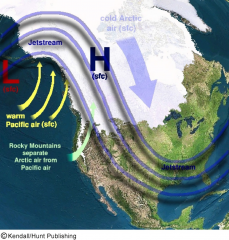
Cold air is very shallow, extending 1-2 kilometers above ground. |
|
|
Cold Wave weather Pattern 2 |
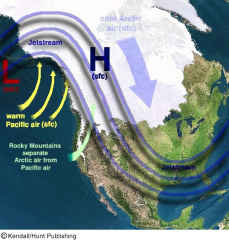
A strong Pacific low enhances the jet stream. |
|
|
Cold Wave weather Pattern 3 |
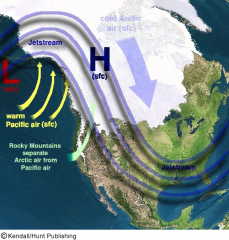
High pressure systems usually have clear skies and light winds! They "trap" the cold air! |
|
|
Mountain storms |
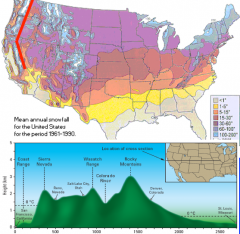
Air must rise nearly 2 kilometers = majority of moisture condensed out as Pressure. |
|
|
Source of mountain snowstorms 1 |
Develop during the passage of large scale weather systems. |
|
|
Source of mountain snowstorms 2 |
Many of those systems originate over the central and western Pacific Ocean. |
|
|
Source of mountain snowstorms 3 |
Temperature of the surface air over the ocean is 40 to 60 degrees F. |
|
|
Source of mountain snowstorms 4 |
Laden with moisture. |
|
|
Source of mountain snowstorms 5 |
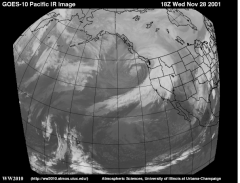
Moisture streams are called atmospheric rivers. |
|
|
Source of mountain snowstorms 6 |
Typical weather systems and the atmospheric river. |
|
|
Source of mountain snowstorms 7 |

Strong cyclones develop over the Pacific, mainly south and east of the Aleutian Islands --- one of the preferred regions for extratropical cyclone formation (Aleutian low) |
|
|
Source of mountain snowstorms 8 |
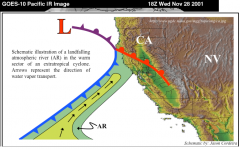
Life cycle of these cyclones occur mostly over open water. |
|
|
Source of mountain snowstorms 9 |
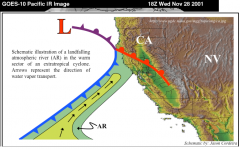
Occluded when arrive at west coast. |
|
|
Source of mountain snowstorms 10 |
T-storms are rare and air is relatively stable. |
|
|
Storms on the East slope of the Rockies 1 |
Storms can occur with relatively, moist eastern wind. |
|
|
Storms on the East slope of the Rockies 2 |
Less common, but can produce enormous amounts of snow (more than 1 foot) |
|
|
Storms on the East slope of the Rockies 3 |
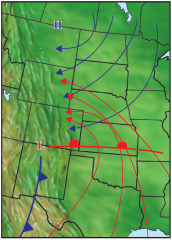
Two pressure patterns: High on the north, and low on the south (Four Corners low). |
|
|
Storms of the East slope of the Rockies 4 |
Upslope storm. |
|
|
Thunderstorm 1 |
A thunderstorms is one of several comulonimbus clouds accompanied by lightening and thunder. |
|
|
Thurderstorm 2 |
Four elements of formation: Moist air, unstable air, lifting force and vertical wind shear. |
|
|
Thunderstorms Hazards |
Lightning, hail, tornadoes, flash floods. |
|
|
Components of a Thunderstoms |
Lightning, precipitation, hail, wind, tornadoes. |
|
|
Types of Thunderstorms: Airmass or Ordinary Cell 1 |
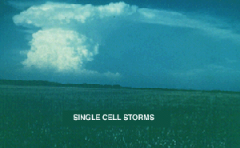
Limited wind shear. |
|
|
Types of Thunderstorms: Airmass or Ordinary Cell 2 |
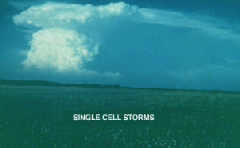
Often form along the shallow boundaries of converging surface winds. |
|
|
Types of Thunderstorms: Supercell or Severe 1 |

Precipitation doesn't fall into the updraft. |
|
|
Types of Thunderstorms: Supercell or Severe 2 |

Cluster of cells at various developmental stages due to cold outflow undercutting updraft. |
|
|
Thunderstorm stages 1 |

Developing (cumulus) |
|
|
Thunderstorm stages 2 |
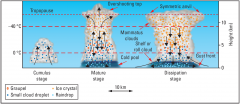
Mature, notice the heavy rain. |
|
|
Thunderstorm stages 3 |
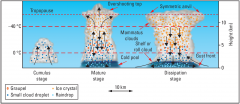
Dissipating |
|
|
Thunderstorms: Single Cell |
Heavy rain (brief), small hail, wind gusts/downbursts, and weak tornadoes. |
|
|
Thunderstorms: Multicell 1 |
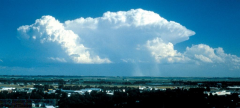
Flash floods, moderate hail, wind gusts/downbursts, weak tornadoes. |
|
|
Mesoscale Convective Complex 1 |
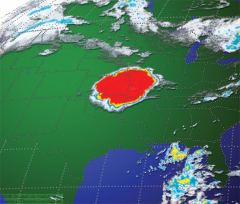
An organanized mass, or collection, of thunderstorms, that extends across a large region called a mesoscale comvertive complex (MCC). |
|
|
Mesoscale Convective Complex 2 |
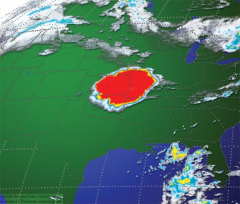
With weak upper level winds, such MCC's can regenerate new storms and last for upwards of 12 hours and may bring hail, tornadoes and flash floods. |
|
|
Mesoscale Convective Complex 3 |

They often form beneath a ridge of high pressure. |
|
|
A squall line (MCS) |
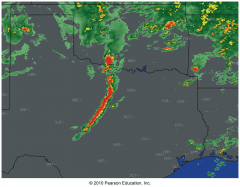
|
|
|
Thunderstorms: Multicell 2 |
Clusters |
|
|
Thuderstorms: Multicell 3 |
Lines: Squall lines and Bow echos. |
|
|
Supercell Thuderstorms 1 |
Defined by mid-level rotation (mesocyclone), highest velocity near updraft core. |
|
|
Supercell Thunderstorms 2 |
Supercell form under the following conditions: High CAPE, capping layer, cold air aloft, large wind shear. |
|
|
Supercell Thunderstorms 3 |
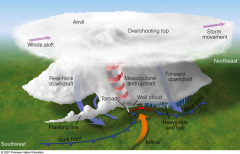
A classic tornadic supercell thunderstorms showing updrafts and downdrafts. |
|
|
Supercell Thunderstorms 4 |
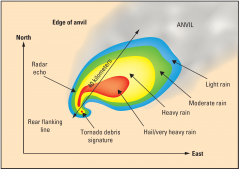
|
|
|
Thunderstorms; Supercell |
Heavy rain (flash flood), large hail, strong wind gusts/downbursts, and strong tornadoes. |
|
|
Tornado life cycle |
4 stages |
|
|
Tornado formation 1 |
Step 1: Tilting wind shear cause the storm's updraft to totate. |
|
|
Tornado formation 2 s |
Step 2: The formation of a low-level mesocyclone |
|
|
Tornado formation 3 |
Step 3: Rotation extends to the ground, top-down process, bottom-up process, and Tornadoes formation in a non-supercell storm. |
|
|
Tornado formation 4 |
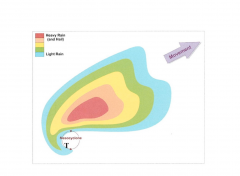
Tornadoes likely occurs on the south side of the mesocyclone (the hook echo) |
|
|
Classic Supercells 1 |

Preferred Spotter Position is Dependent on Storm on Storm Motion: take a position in the inflow to the right of the storm track. |
|
|
Classic Supercell 2 |
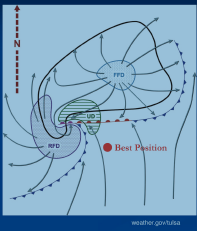
Benefits of This Vantage Point: Sense Inflow/outflow, unobstructed view of Updraft region, and Safety. |
|
|
Seasonal March of Tornadoes |

|
|
|
Hail Storm Dynamics |
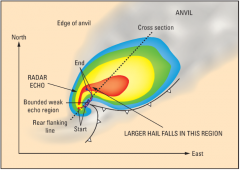
|
|
|
Hail Stone Growth 1 |
Wet growth: the water does not freeze on the ice immediately. Instead, liquid water spreads across tumbling hailstones and slowly freezes. Since the process is slow, air bubbles can escape resulting in a layer of clear ice. |
|
|
Hail Stone Growth 2 |
Dry growth: the water droplet freezes immediately as it collides with the ice particle. The air bubbles are "frozen" in place, leaving cloudy ice. |
|
|
Hail Days 1 |
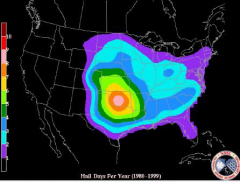
Mean annual number of days with hail > 0.75 inches |
|
|
Hail Days 2 |
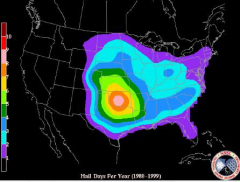
Mean annual number of days with hail > 2 inches. |
|
|
Hailswath and hail-streaks 1 |
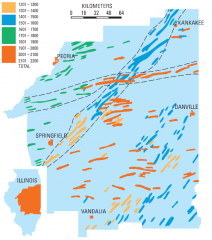
Hail tornadoes are similar in term of the intermittency of their paths. |
|
|
Hailswath and hail-steaks 2 |
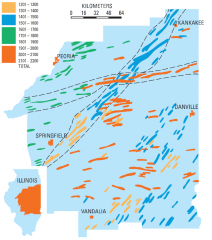
Hailswaths: continious areas with wider and longer area of hailfall (areas inside dash lines). |
|
|
Hailswath and hail-streaks 3 |
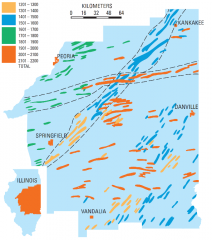
Hail streaks: small continuous region of hail coverage. Usually 1 - 2 wide and very in length from a few to > 60 km. |
|
|
Classification of Tropical Weather Systems 1 |
Organized thunderstorm cluster, no closed circulation: Tropical Disturbance. |
|
|
Classification of Tropical Weather Systems 2 |
Identifiable pressure drop and closed circulation: Winds less than 39 miles per hour; Tropical depression. |
|
|
Classification of Tropical Weather Systems 3 |
Identifiable pressure drop and closed circulation:39 miles per hour wind less than 74 miles per hour; Tropical storm. |
|
|
Classification of Tropical Weather Systems 4 |
Identifiable pressure drop and closed circulation:74 miles per hour less than wind; Hurricane. |
|
|
Saffir-Simpson scale 1 |
Category 1: Winds 74 - 95 miles per hour and there will some damage. |
|
|
Saffir-Simpson scale 2 |
Category 2. Winds 96 - 110 miles per hour and there will extensive damage. |
|
|
Saffir-Simpson Scale 3 |
Category 3: Winds 111 - 130 miles per hour and there will be devastating damage. |
|
|
Saffir-Simpson Scale 4 |
Category 4: Winds 131 - 155 miles per hour and there will be catastrophic damage. |
|
|
Saffir-Simpson Scale 5 |
Category 5: Winds more than 155 miles per hour and there cill be catastophic damage. |
|
|
Saffir-Simpson Scale 6 |
During 1924 - 2010, only 32 Atlantic basin hurricanes have been rated Category 5, and only a fraction of those have made landfall with that intensity. |
|
|
Saffir-Simpson 7 |
In 2005, a record four hurricanes: Emily, Katrina, Rita, Wilma reached Category 5 intensity. |
|
|
Tropical cyclones 1 |
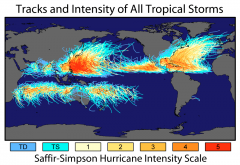
A global perspective. |
|
|
Tropical cyclones 2 |
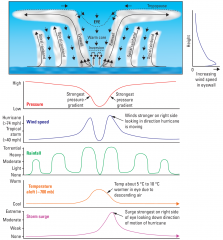
|
|
|
The environement required for Tropical cyclones formations 1 |
Sea surface temperature required must exceed 80 degrees F. |
|
|
The environments required for Tropical cyclones 2 |
The surface layer of warm water in the ocean must be sufficiently deep, typically about 200 feet of more |
|
|
The environments required for Tropical cyclones 3 |
The middle troposphere much cointain sufficient moisture. |
|
|
The environment required Tropical cyclones 4 |
The wind in the atmosphere much not change substantially over height (weak vertical wind shear). |
|
|
The environment required Tropical cyclones 5 |
The location must be at least least 5 degrees north or south of the equator. |
|
|
Hurricane Formation 1 |
Trigger mechanisms for initial thunderstorms: Interstropical convergence zone. |
|
|
Hurricane Formation 2 |
Trigger mechanisms for initial thuderstorms: Easterly waves in trade wind flow. |
|
|
Hurricane Formation 3 |
Trigger mechanims for initial thunderstorms: Occlusion of extratropical cyclone over tropical waters. |
|
|
Hurricane Destruction 1 |
Storm surge |
|
|
Hurricane destruction 2 |
Winds |
|
|
Hurricane destruction 3 |
Tornados |
|
|
Hurricanes destruction 4 |
Inland Flooding |
|
|
Storm surge causes 1 |
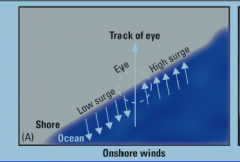
Onshore winds |
|
|
Storm surge causes 2 |
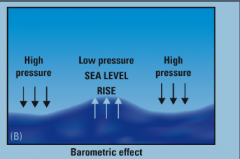
Barometric effect |
|
|
Storm surge enhancing factors 1 |
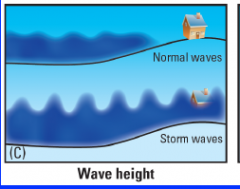
Wave height |
|
|
Storm surge enhacing factors 2 |
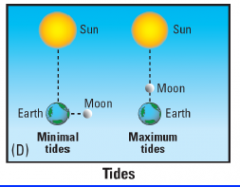
Tides |
|
|
Storm enhancing factors 3 |

Shape of coastline |
|
|
Hurricane spawned Tornadoes 1 |
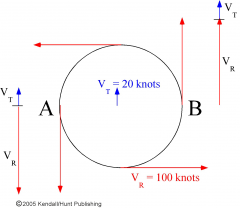
|
|
|
Hurricane Spawned Tornadoes 2 |
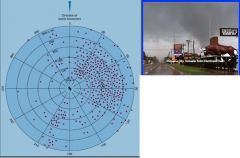
|
|
|
Causes of cyclones Deaths |
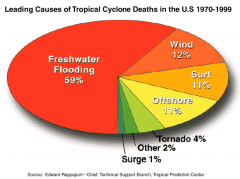
|

